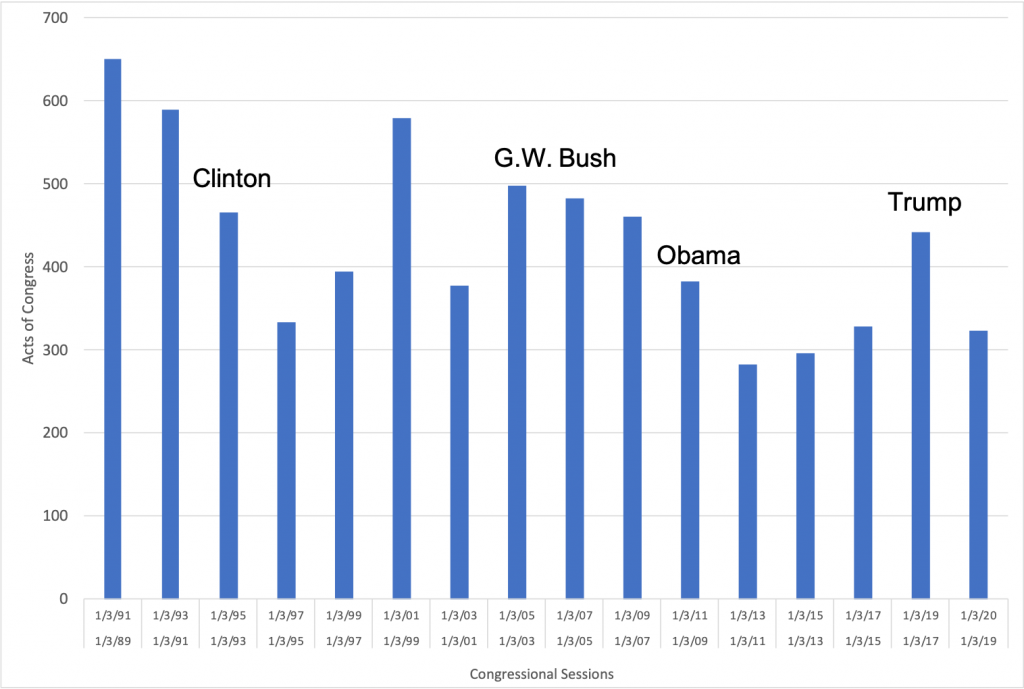In an effort to keep the ball rolling, as it were, with more frequent blog entries in 2021, here is a second installment. Picking up where we left off last time, in D.C., this entry relates to what the next Congress may bring for legislative change, most notably related to energy and the environment. Although I began my literature review with energy and the environment, the effort quickly devolved into a look at whether alignment with one party between Congress at the White House resulted in the passage of more laws. I figured this might be a good indication of the likelihood for passage of new laws related to energy and the environment. Although I know there are those who have examined this topic in much more depth than I did this morning, the quick answer to the question about whether party alignment leads to bills passed into law is “no”. This question, though, sent me down the proverbial rabbit hole (I am reminded of looking over my kids’ shoulders to see the tens of open browsing tabs, wondering how this could be a thing … only to find myself doing something similar – side note, difference for me is that I am incapable of letting this situation persist as I need to close out windows, read texts and emails, etc., so that there are no “unread” flags. Yeah, I’m sure it’s diagnosable.).
To elaborate on the quick answer that alignment between the three branches of government doesn’t necessarily seem to translate into more laws, my review of the last 30 years of legislative activity shows no apparent correlation to anything related to which party controls the House, the Senate or the Presidency. Now, I am using as my proxy number of laws passed in a given Congress as opposed to analyzing the importance (defined as general impacts on society) of the legislation passed. See the number of laws passed over the years in the following graphic (for further info, this nifty little table shows that, in a given Congress, only about 3-5% of the bills introduced pass into law.). I layered onto the graphic the Congresses (5 of them to be exact) where the three branches aligned with one party during the past 30 years. Interestingly, the high water marks for legislation passed (1989-2003 and 1999-2001) came when both houses of Congress were aligned with one party while the presidency was held by the other (G.H.W. Bush for 1989-2003 and Bill Clinton for 1999-2001).

That said, “major” (defined as both significant in terms of effect and marked by strong differences between the parties) legislation has passed during recent Congresses when the parties were aligned (witness the Affordable Care Act in 2010 under Obama and the Tax Cuts and Jobs Act of 2017 under Trump). So, although there may not be a large volume of laws passed in the next two years, we may see major legislation passed.
Getting back to energy and the environment, although not widely reported, the 116th Congress (which ended on January 3, 2021) passed a major of piece of energy and environmental legislation, The Energy Act of 2020. The law was folded into the Covid-19 and government funding package (H.R. 133) and so didn’t draw as much attention. However, the bipartisan law, as described by its sponsors, “represents the first modernization of our nation’s energy policies in well over a decade.” Since none of the legislators mentioned which was the last major piece of energy legislation to pass, I looked into it a bit more. Turns out it was the Energy Independence and Security Act of 2007 (originally called the Clean Energy Act of 2007). That law sought to “move the United States toward greater energy independence and security, to increase the production of clean renewable fuels, to protect consumers, to increase the efficiency of products, buildings, and vehicles, to promote research on and deploy greenhouse gas capture and storage options, and to improve the energy performance of the Federal Government, and for other purposes.” The Energy Act, on the other hand (with some similar language), is described:
(as supporting) the transition to a low-carbon economy by investing in clean energy, distributed energy resources, energy storage systems, and microgrids. The Energy Act prioritizes research, development, and demonstration of technologies to reduce greenhouse gas emissions from the power sector, industry, and buildings. The package focuses on energy storage; advanced nuclear; carbon capture, utilization, and storage; carbon removal; renewable energy; critical minerals and materials; fusion; industrial technologies; smart manufacturing; and grid modernization, among other areas. It reauthorizes popular, proven-effective programs like ARPA-E and Weatherization Assistance. (Daily Energy Insider)
So, the Energy Act of 2020 does quite a bit, which begs a larger question about whether the 117th Congress (current) will have the appetite to do much more than tinkering with existing energy-related laws. To be sure, more can be done, particularly in the area of climate change. But, we will have to see how expansive such legislation will become and whether it will be focused heavily on economic recovery as we (hopefully) end the Covid-19 pandemic. It very well could be that the focus shifts to things the Biden Administration can do, particularly internationally. As a first step, Biden will likely rejoin the Paris climate accord. But, it remains to be seen how much Biden and this Congress will accomplish.
